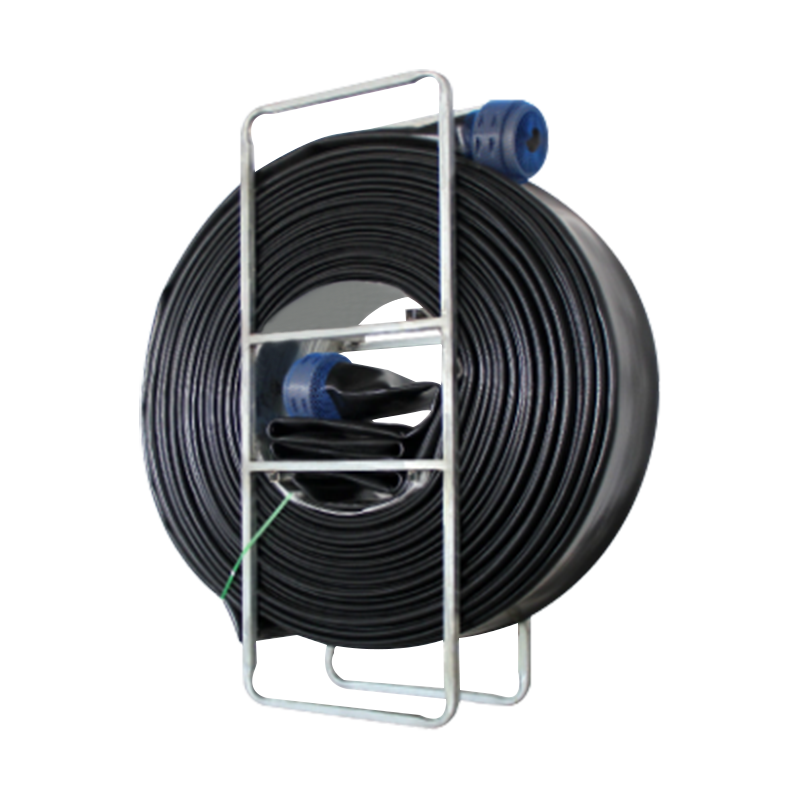Don't hesitate to send a message
Single jacket, EPDM rubber liner Features • 100% high tenacity polyester jacket, high-grade EPDM rub...
In fracturing operations, fracturing hoses must withstand high-pressure pulsation (pressure fluctuations) and mechanical vibration, posing extreme demands on their structural design and material properties. Below are the core mechanisms through which fracturing hoses address these challenges:

2. Coupling Design: Reducing Stress Concentration and Leakage Risks
Integral Coupling
The coupling is molded into the hose body through vulcanization, eliminating the bolt loosening issues associated with traditional flanged connections.
Principle: The integral structure directly transfers pressure to the steel wire braid layer, minimizing stress concentration at the coupling.
Vibration-Damping Coupling
Incorporates elastic buffer pads (e.g., rubber or polyurethane) within the coupling to absorb vibration energy and prevent metal fatigue.
Application: Commonly used in connections to vibration-intensive pumping equipment.
3. Rubber Material Selection: Balancing Flexibility and Wear Resistance
Inner Liner
Utilizes hydrogenated nitrile rubber (HNBR) or thermoplastic polyurethane (TPU), offering high elastic modulus and wear resistance to withstand abrasion from sand-laden fracturing fluids.
Case Study: TPU inner liners reduce wear rates by 50% compared to traditional NBR rubber under sand particle friction.
Outer Cover
Employs chloroprene rubber (CR) or nitrile rubber (NBR), providing weather resistance and anti-aging properties to prevent cracking from UV exposure and ozone.
4. Dynamic Testing and Validation: Ensuring Hose Longevity
Pressure Pulsation Testing
Simulates real-world pressure fluctuations (e.g., 0–15,000 psi cycles) to assess the hose's fatigue life.
Standard: API 7K specifications require hoses to pass at least 100,000 pressure cycle tests.
Vibration Testing
Mounts the hose on a vibration table, applying vertical/horizontal vibrations to evaluate the sealing performance of couplings and hose bodies.
Metric: Vibration frequency range typically 5–50 Hz, acceleration not exceeding 10g.
5. Real-World Example: Application of Fracturing Hose in a Shale Gas Well
Operating Conditions: Fracturing fluid flow rate of 200 bbl/min, pressure of 10,000 psi, and sand content of 10%.
Solution:
Adopts a 6-layer steel wire braid + aramid fiber composite reinforcement layer.
Utilizes TPU inner liner and CR outer cover.
Coupling features an integral design with a rubber buffer pad.
Outcome: The hose operated continuously for 100 hours without leakage, with coupling displacement under vibration testing measuring less than 0.5 mm.

Single jacket, EPDM rubber liner Features • 100% high tenacity polyester jacket, high-grade EPDM rub...

Single jacket, TPU liner •High-tenacity polyester yarn, circular woven in twill weave/plain weave,T ...


Fire cabinets are designed to accommodate fire hose,valve and other firefighting equipment. Type 201...

Nitrile covered hose •Nitrile/TPR blend as cover and lining, with 100% high-tenacity polyester yarn ...

Single jacket, TPU liner •High-tenacity polyester yarn, circular woven in twill weave, TPU lining, f...

Marine hose Single jacket, PVC liner •100% high tenacity polyester yarn, circular woven in twill wea...

Marine hose Single jacket, PVC liner, PU coated •100% high tenacity polyester yarn,c ircular woven i...
 Call Us
Call Us
+86 159-5116-9511
 Need Support
Need Support
 Head Office
Head Office
No.58, Kechuang Road, Sixiang Street Medicine Gaoxin District Taizhou City, Jiangsu Province
In the fire emergency system, the fire hose is an important tool for delivering water and extinguishing fires. With the development of material technology, PVC Lined Fire Hose has played an important ...
Copyright © Taizhou Shenlong Fire Science and Technology Co., Ltd. All Rights Reserved.
 Fire Hose Manufacturers, Fire Hydrant Hose Factory
Fire Hose Manufacturers, Fire Hydrant Hose Factory
